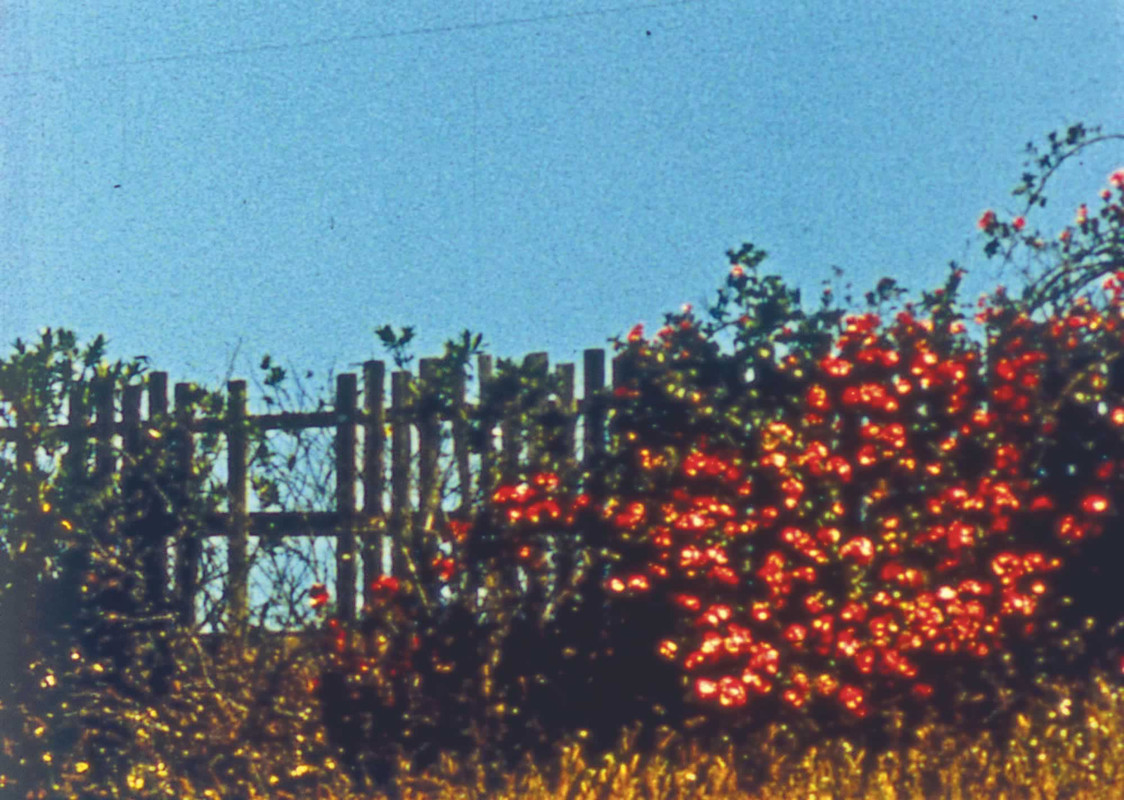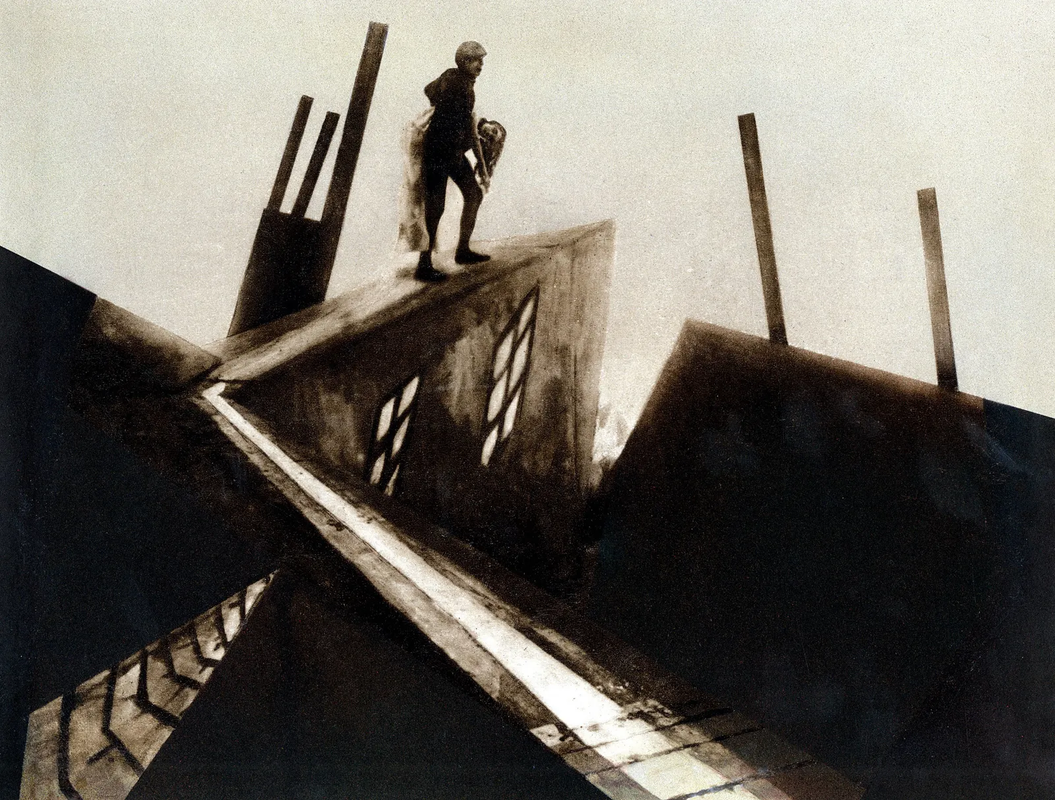War Machine (Duvet Brothers, 1984)
Jan
21
the passing of Orwell

A repurposed TV still of a battle ship billowing thick black smoke with the text WAR MACHINE superimposed over it.
A scratch video from 1984 on the date George Orwell died (1950). Date of production is either 84 or 85.
experimentalfilm
“All my life, hold me close to your heart
But all else above
Hold my love, darling, just hold my love”All My Life (Bruce Baillie, 1966)
Jan
18
roses

A still of a red rose bush next to a fence. Image via à pala de walsh. DP: Bruce Baillie.
Roses for the end of the Wars of the Roses (note: January 18 is when Henry VII married Elizabeth of York in 1486; the wars would continue until June 16 the following year).
– Ella Fitzgerald, All My Life (Sidney D. Mitchell & Sammy Stept), 1936
In one continuous shot, the camera tracks a fence and rose bushes while Ella Fitzgerald's 1936 debut song All My Life is playing.
“The Kinoautomat in the Czechoslovak Pavilion is a guaranteed hit of the World Exposition, and the Czechs should build a monument to the man who conceived the idea, Radúz Činčera.”Kinoautomat: Člověk a jeho dům [Kinoautomat / One Man and His House] (Ján Roháč, Radúz Činčera + Vladimír Svitáček, 1967)
Jan
10
Representation of the People Act 1918

The audience about to vote for one of two scenes, with two presenters on stage.. DP: Jaromír Šofr.
Voting, for the Representation of the People Act 1918, UK.
Made for the Czechoslovak Pavilion at #Expo67 in #Montréal, Kinoautomat was the world's first interactive film. During nine moments in the story, a moderator would appear on the stage, and ask the audience where the story should go now. Depending on the votes, one of two reels would play.
– The New Yorker
After its very successful performance at Expo 67, and a one year run in Prague, Kinoautomat was banned by the Czechoslovakian government.
“There's no clue to the identify of Franz Kindler; except one little thing. He has a hobby that almost amounts to a mania: clocks.”The Clock (Christian Marclay, 2010)
Dec
31
Hogmanay

Prof. Charles Rankin (Orson Welles) during the climax in The Stranger (1946). The clocktower strikes midnight. DP: Russell Metty.
Midnight: it's Hogmanay in Scotland.
– Mr. Wilson
The Clock takes place over – and lasts – 24 hours, with each moment either being shown in a film still or mentioned by characters during a scene. In total, there are over 12 000 scenes edited into Marclay's tour de force.
Alan “How long will I live?” Cesare “Till the break of dawn.”Das Cabinet des Dr. Caligari [The Cabinet of Dr. Caligari] (Robert Wiene, 1920)
Dec
25
Hanukkah + Christmas


Cesare (Conrad Veidt) escapes with Jane (Lil Dagover) in his arms. Composition and distribution of light and shadow – much of which was painted directly on the set pieces – strike a strong resemblance with the oldest known survived photograph by Nicéphore Niépce from ca. 1822 – 1827. DP: Willy Hameister.
A favourite scene featuring light for Hanukkah and Christmas.
Die Sage vom alten Hirten Xeudi und seinem Freund Reiman [The Legend of the Old Shepherd Xeudi and His Friend Reimann] (Hans-Jakob Siber, 1973)
Dec
11
International Mountain Day

The two friends setting off on their track of the Swiss mountains. Their chalet can be seen in the foreground. DP: Hans-Jakob Siber.
Mountain living on International Mountain Day. Available to watch via the Zürcher Hochschule der Künste's media archive.
The End (Christopher Maclaine, 1953)
Nov
13
ice cream

A man suggestively licks an ice cream cone. DP: Jordan Belson.
Die Sage vom alten Hirten Xeudi und seinem Freund Reiman [The Legend of the Old Shepherd Xeudi and His Friend Reimann] (Hans-Jakob Siber, 1973)
Sep
3
potatoes

Gloomy potatoes and a small metal peeler on a wooden surface. DP: Hans-Jakob Siber.
Available to watch via the Zürcher Hochschule der Künste's media archive.
Wieczne pretensje [Permanent Objections] (Grzegorz Królikiewicz, 1975)
Jul
29
kotlet mielony

Two men in suits in what appears to be a factory canteen. One offers the other a large piece of kotlet mielony or kotlet schabowy, a type of #schnitzel. DP: Bogdan Dziworski.
Doktor Glas [Doctor Glas] (Mai Zetterling, 1968)
May
27
akvavit

A man (Per Oscarsson) raises a glass and peers though its ribs and liquids. DP: Rune Ericson.